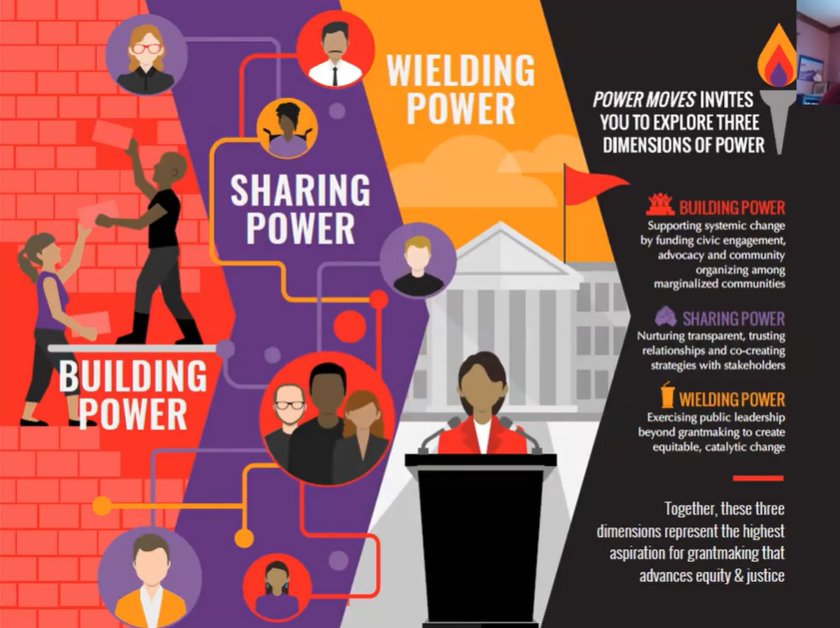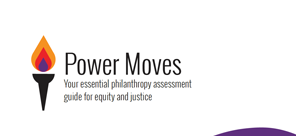Overview of Power Moves
POWER MOVES: Your Essential Philanthropy Assessment Guide for Equity and Justice is a complete self-assessment toolkit to determine how well foundations are building, sharing, and wielding power and how to identify ways to transform your programs and operations for lasting, equitable impact.
Like most grantmakers who care about improving the health, safety and security of our communities, you want to know that your work is making a difference on the issues and communities you care about.
So, you turn to periodic assessments or evaluations to determine how well you’re doing.
But traditional assessments often overlook the critical relationship between power and equity in achieving lasting equitable impact.
POWER MOVES is the only self-assessment guide that will help you view your strategies and practices through the lens of the power-equity relationship.

initiativeNavVideoTextBlock-913Title
Are you leveraging the full power of your foundation for equity and justice?
Now you can find out if your strategies and practices:
- Catalyze equitable, long-term solutions instead of temporary fixes.
- Earn the trust of peers, partners and the communities you serve.
- Position you as a legitimate, influential and relevant voice on issues you care about.
Inside Power Moves
Kickstart your power assessment when you and your team are ready. Assess a program or your entire operations for one, two or all dimensions of power. You control the pace, time and resources to dedicate to a self-assessment.
POWER MOVES includes ready-to-use guides, insightful anecdotes and comprehensive resources for each dimension of power to help you on your power journey towards high-impact giving.
Overview of Build Power
Build power to catalyze equitable, long-term, community-driven solutions instead of temporary fixes.
Our research shows that funders who successfully make grants that strengthen capacity and leadership of underserved communities, and address root causes of inequities follow these guidelines:
- They are explicit about advancing systemic equity for specific marginalized communities in their goals, strategies and operations.
- They fund under-resourced communities, so they are their own agents of change.
- They fund cross-issue approaches.
- They fund for the long term while also being responsive to emerging or urgent opportunities.
What to expect in this section
1. Building power in Action: Hill-Snowdon Foundation.
2. Kick-off group exercise to explore questions such as:
- What does it mean for us to advance equity? To build power?
- What are our positive associations with the idea of building power and equity?
- What are our negative associations? What assumptions or fears underlie them?
3. Sample questionnaires to guide the collection of internal data and external feedback vital to your assessment. Topics include:
- To what extent does the foundation embody equity, diversity and inclusion internally?
- What evidence do stakeholders see that our current goals and strategies are likely to achieve more equitable systems and outcomes for marginalized communities?
- How do we support and empower marginalized communities to define solutions and lead change?
4. Discussion guide to help your team analyze and reflect on your synthesized internal and external data and feedback. Examples of questions include:
- What surprised us about constituent feedback on this topic?
- To what extent do we have a shared understanding with our grantees about how to build power to advance equity?
- What are some outside-the-box ideas we’ve heard about that could help us support power building?
- What additional information would we need to decide which strategies to pursue?
5. Next steps tools, including:
- A visual aid to see where you are on the continuum, from beginning to building power to fully building power.
- Several tips for implementing new power-building strategies, such as: evaluating your grantmaking with an equity lens.

initiativeNavVideoTextBlock-913Title
Overview of Share Power
Share power to earn the trust of peers, partners and the communities you serve.
Our research shows that funders who successfully hand over some control of their inherent power follow these guidelines:
- They are very responsive, inclusive and transparent in communicating with current and prospective grantees.
- They invest in the success of their grantees.
- They solicit input from communities they seek to benefit, going beyond the usual suspects.
What to expect in this section
1. Sharing Power in Action: California Civic Participation Funders.
2. Kick-off group exercise for your assessment team, to explore questions such as:
- What does it mean to each of us to “share power” with grant partners?
- Who do we define as our community or constituency beyond grantees?
- What assumptions or fears do we have about building trust and sharing power?
3. Sample questionnaires to guide the collection of internal data and external feedback vital to your assessment. Topics include:
- How burdensome are our application, reporting and evaluation processes for applicants and grantees? Do they pose any unintentional barriers for organizations led by people of color, people with disabilities or other marginalized groups?
- How does our foundation gain honest (preferably anonymous) input and feedback from grant partners and applicants? Do we analyze the feedback with an equity lens? How do we act on this feedback?
4. Discussion guide to help you make meaning of the synthesized internal and external data and feedback and engage in group reflection. Examples of questions include:
- In what ways is the foundation demonstrating trust in its grant partners? How are grantees showing they trust us?
- What do other community stakeholders think of the foundation, and do our prioritized communities see us as a true partner?
- How would sharing power more than the foundation does now help us better achieve our goals? What would be reasons not to further share power?
5. Next steps tools, including:
- A visual aid to see where you are on the continuum, from beginning to share power to fully sharing power.
- Several tips for implementing new power-sharing strategies, such as: honing cultural competency, humility and skill in developing honest relationships.
Overview of Wield Power
Wield power to be a legitimate, influential and relevant voice on issues you care about.
Our research shows that funders who successfully and responsibly leverage their reputation, financial assets and capacity to advance equitable goals follow these guidelines:
- They convene grantees and community stakeholders while playing supportive participant roles at other convening tables.
- They organize and collaborate with peers in philanthropy and other sectors such as government.
- They bring visibility to issues and elevate the voices of marginalized community members by using their reputation and expertise to inform, raise awareness and advocate.
What to expect in this section
1. Wielding Power in action: The Pittsburgh Foundation.
2. Kick-off group exercise for your assessment team, to explore questions such as:
- What does it mean for our foundation and its leaders to wield power?
- What are our positive associations with the idea of wielding power? What excites us about this?
- How have we seen peers or our community successfully wield power?
3. Sample questionnaires to guide the collection of internal data and external feedback vital to your assessment. Topics include:
- Does the foundation have guidelines for taking public stands on current issues or events? How often has a leader of the foundation taken public stands in the last year?
- Has the foundation used its convening, communications and engagement tools to amplify the positions, voices and activities of marginalized constituencies?
- Has the foundation ever offered to use its assets and investment tools to support grantee or community goals?
4. Discussion guide to help you make meaning of the synthesized internal and external data and feedback and engage in group reflection. Examples of questions include:
- What kinds of leadership strategies (if any) are we pursuing?
- What kinds of leadership strategies (if any) do we seem to be avoiding?
- How might some of these leadership strategies help us better achieve our goals? The goals of our grant partners?
- How do we need to show up as a leader to most effectively support the issue or community we care about?
5. Next steps tools, including:
- A visual aid to see where you are on the continuum, from beginning to wield power to fully wielding power.
- Several tips for implementing new power-wielding strategies, such as: anticipating pushback when you advocate on issues.

initiativeNavVideoTextBlock-913Title
Like most grantmakers who care about improving the health, safety and security of our communities, you want to know that your work is making a difference on the issues and communities you care about.
So, you turn to periodic assessments or evaluations to determine how well you’re doing.
But traditional assessments often overlook the critical relationship between power and equity in achieving lasting equitable impact.
POWER MOVES is the only self-assessment guide that will help you view your strategies and practices through the lens of the power-equity relationship.

initiativeNavVideoTextBlock-228Title
Are you leveraging the full power of your foundation for equity and justice?
Now you can find out if your strategies and practices:
- Catalyze equitable, long-term solutions instead of temporary fixes.
- Earn the trust of peers, partners and the communities you serve.
- Position you as a legitimate, influential and relevant voice on issues you care about.
Inside Power Moves
Kickstart your power assessment when you and your team are ready. Assess a program or your entire operations for one, two or all dimensions of power. You control the pace, time and resources to dedicate to a self-assessment.
POWER MOVES includes ready-to-use guides, insightful anecdotes and comprehensive resources for each dimension of power to help you on your power journey towards high-impact giving.
Overview of Build Power
Build power to catalyze equitable, long-term, community-driven solutions instead of temporary fixes.
Our research shows that funders who successfully make grants that strengthen capacity and leadership of underserved communities, and address root causes of inequities follow these guidelines:
- They are explicit about advancing systemic equity for specific marginalized communities in their goals, strategies and operations.
- They fund under-resourced communities, so they are their own agents of change.
- They fund cross-issue approaches.
- They fund for the long term while also being responsive to emerging or urgent opportunities.
What to expect in this section
1. Building power in Action: Hill-Snowdon Foundation.
2. Kick-off group exercise to explore questions such as:
- What does it mean for us to advance equity? To build power?
- What are our positive associations with the idea of building power and equity?
- What are our negative associations? What assumptions or fears underlie them?
3. Sample questionnaires to guide the collection of internal data and external feedback vital to your assessment. Topics include:
- To what extent does the foundation embody equity, diversity and inclusion internally?
- What evidence do stakeholders see that our current goals and strategies are likely to achieve more equitable systems and outcomes for marginalized communities?
- How do we support and empower marginalized communities to define solutions and lead change?
4. Discussion guide to help your team analyze and reflect on your synthesized internal and external data and feedback. Examples of questions include:
- What surprised us about constituent feedback on this topic?
- To what extent do we have a shared understanding with our grantees about how to build power to advance equity?
- What are some outside-the-box ideas we’ve heard about that could help us support power building?
- What additional information would we need to decide which strategies to pursue?
5. Next steps tools, including:
- A visual aid to see where you are on the continuum, from beginning to building power to fully building power.
- Several tips for implementing new power-building strategies, such as: evaluating your grantmaking with an equity lens.

initiativeNavVideoTextBlock-228Title
Overview of Share Power
Share power to earn the trust of peers, partners and the communities you serve.
Our research shows that funders who successfully hand over some control of their inherent power follow these guidelines:
- They are very responsive, inclusive and transparent in communicating with current and prospective grantees.
- They invest in the success of their grantees.
- They solicit input from communities they seek to benefit, going beyond the usual suspects.
What to expect in this section
1. Sharing Power in Action: California Civic Participation Funders.
2. Kick-off group exercise for your assessment team, to explore questions such as:
- What does it mean to each of us to “share power” with grant partners?
- Who do we define as our community or constituency beyond grantees?
- What assumptions or fears do we have about building trust and sharing power?
3. Sample questionnaires to guide the collection of internal data and external feedback vital to your assessment. Topics include:
- How burdensome are our application, reporting and evaluation processes for applicants and grantees? Do they pose any unintentional barriers for organizations led by people of color, people with disabilities or other marginalized groups?
- How does our foundation gain honest (preferably anonymous) input and feedback from grant partners and applicants? Do we analyze the feedback with an equity lens? How do we act on this feedback?
4. Discussion guide to help you make meaning of the synthesized internal and external data and feedback and engage in group reflection. Examples of questions include:
- In what ways is the foundation demonstrating trust in its grant partners? How are grantees showing they trust us?
- What do other community stakeholders think of the foundation, and do our prioritized communities see us as a true partner?
- How would sharing power more than the foundation does now help us better achieve our goals? What would be reasons not to further share power?
5. Next steps tools, including:
- A visual aid to see where you are on the continuum, from beginning to share power to fully sharing power.
- Several tips for implementing new power-sharing strategies, such as: honing cultural competency, humility and skill in developing honest relationships.

initiativeNavVideoTextBlock-228Title
Overview of Wield Power
Wield power to be a legitimate, influential and relevant voice on issues you care about.
Our research shows that funders who successfully and responsibly leverage their reputation, financial assets and capacity to advance equitable goals follow these guidelines:
- They convene grantees and community stakeholders while playing supportive participant roles at other convening tables.
- They organize and collaborate with peers in philanthropy and other sectors such as government.
- They bring visibility to issues and elevate the voices of marginalized community members by using their reputation and expertise to inform, raise awareness and advocate.
What to expect in this section
1. Wielding Power in action: The Pittsburgh Foundation.
2. Kick-off group exercise for your assessment team, to explore questions such as:
- What does it mean for our foundation and its leaders to wield power?
- What are our positive associations with the idea of wielding power? What excites us about this?
- How have we seen peers or our community successfully wield power?
3. Sample questionnaires to guide the collection of internal data and external feedback vital to your assessment. Topics include:
- Does the foundation have guidelines for taking public stands on current issues or events? How often has a leader of the foundation taken public stands in the last year?
- Has the foundation used its convening, communications and engagement tools to amplify the positions, voices and activities of marginalized constituencies?
- Has the foundation ever offered to use its assets and investment tools to support grantee or community goals?
4. Discussion guide to help you make meaning of the synthesized internal and external data and feedback and engage in group reflection. Examples of questions include:
- What kinds of leadership strategies (if any) are we pursuing?
- What kinds of leadership strategies (if any) do we seem to be avoiding?
- How might some of these leadership strategies help us better achieve our goals? The goals of our grant partners?
- How do we need to show up as a leader to most effectively support the issue or community we care about?
5. Next steps tools, including:
- A visual aid to see where you are on the continuum, from beginning to wield power to fully wielding power.
- Several tips for implementing new power-wielding strategies, such as: anticipating pushback when you advocate on issues.

initiativeNavVideoTextBlock-228Title
Testimonials
Here is what funders who implemented POWER MOVES in their foundations have to say:

“This is more than a toolkit. It is a guide offering multiple points of entry for foundations who want to unpack their translation of privilege into power and the ways which that power can intentionally advance social justice and equity. The structure of the toolkit is a roadmap for those beginning their journey and landmarks and reminders for those further along. It is a solid and needed contribution to the continued evolution of foundation practice.”

“Grantmakers – even the most well-informed and well-intentioned – can still find it challenging to take meaningful action toward more equitable and socially just practices. POWER MOVES offers a deep and practical guide to the intentional and thoughtful wielding and yielding of power. Wherever your organization is in its exploration of power and privilege, this toolkit will help you take the next step.”

“Foundations confront multiple challenges in embracing effective, wise, responsible and relevant philanthropy. POWER MOVES can be a valuable asset in the hands of those who commit to that effort. It offers respect for the diversity of strategies, structures and purposes, which guide those engaged in these ventures, in a world of almost constant debate as to what is the public good and how to achieve it. The toolkit will be especially helpful to family foundations which seek effective strategies for examining their legacy and maximizing their opportunities for philanthropic accomplishment.”

“As a foundation committed to health equity, we are always looking for tools and examples of best practices to help us become more effective grantmakers. Whether you seek to use your grantmaking dollars to advance equity, build authentic and trusting relationships with your grantees or leverage all your assets and resources to catalyze change, POWER MOVES is a resource that can guide the way.”

“Grantmakers and foundations often have a difficult time moving from conversation to practice when tackling a difficult topic in-house at their organization. POWER MOVES is a thoughtful guide designed with and for grantmakers looking to refocus the lens through which they address racial equity and social justice. No matter where you are on that important journey, you’ll find something in this toolkit for you!”
Ready to Learn More about our Power Moves initiative?

